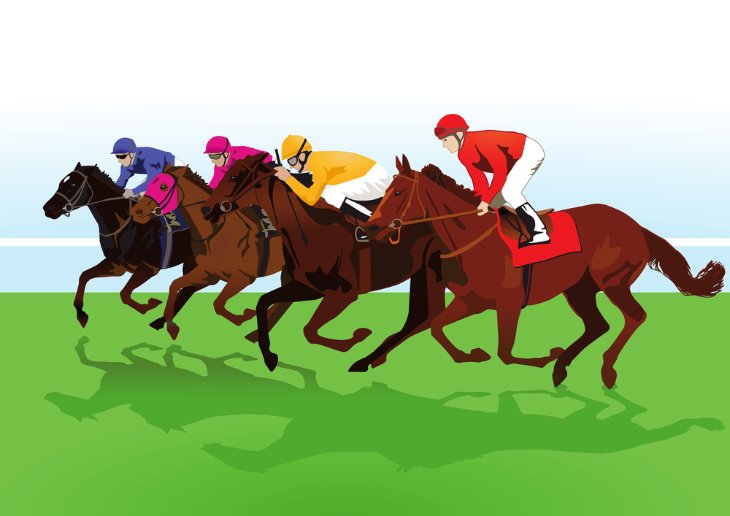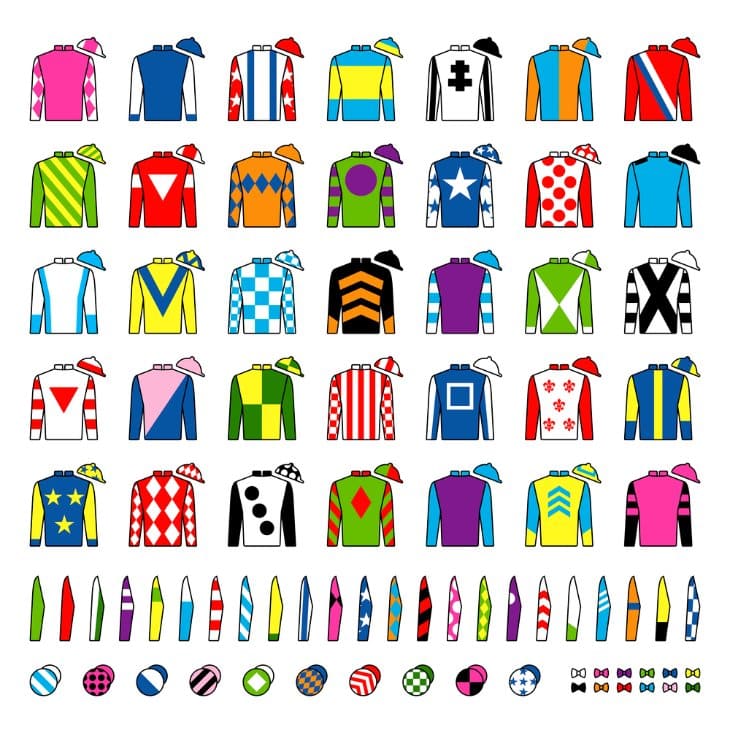Just like any other sport, horse racing also has uniforms. More precisely, jockeys wear specific colours during races and what’s important to keep in mind is that these colours, which are also known as silks, aren’t there just for decorative purposes. They are important for several reasons, which we are going to check in this article. But first, a few words about the history of jockey colours.
Brief History
Horse racing has a long history that spans centuries, and so do jockey silks, as unique clothing of jockeys has been practised for many centuries. We presume that jockey silks can be traced to mediaeval times. In England, knights participating in tournaments often wore colourful and distinctive coats of arms to point out their identity and there is no doubt it had a great influence on jockey clothing as well.
By the 18th century, horse racing was already a popular, professional sport, so the need for a clear system of identification for jockeys and horses became more pressing. Specific colours, and patterns appeared, along with designs of their jockeys' clothes that helped differentiate them from competitors.
As horse racing became more organised and regulated, rules and standards for jockey silks started appearing. For example, the Jockey Club, established in 1750 in England, played a significant role in formalising the use of racing colours, as it introduced a system of registration and record-keeping for silks. In that way, they were sure that no two sets of silks were identical during a race.
Jockey silks are known for their unique colours, bold designs, and intricate patterns. These designs often incorporate the owner's colours, symbols, or insignia, helping to establish a recognizable identity for each horse and jockey combination. Over time, this need to express individuality became an integral part of horse racing's visual appeal.
The whole idea behind jockey silks was to minimise wind resistance and improve performance. Today, modern jockey uniforms may still use silk, but they also incorporate advanced materials and technologies for comfort and safety. These materials help wick away moisture, provide protection, and enhance the overall performance of the jockey.
Of course, different countries and regions have their own traditions and practices related to jockey silks. For example, in the United States, jockey silks are often more colourful, as Americans prefer bold and eye-catching designs. On the other hand, Europeans prefer more subtle, more elegant combinations.
The Importance of Jockey’s Colours
Jockey's colours are an integral part of horse racing history and definitely are a factor that contributes to the overall experience of horse racing. It adds a unique flavour, with a layer of tradition, identity, and excitement to the sport. But besides aesthetics, their importance is also practical and symbolic. So, let’s take a little bit deeper insight:
Identification
Of course, identification is the first thing that comes to mind. In a horse race, particularly when there are several horses competing, accurate identification of both the horses and their jockeys is essential for determining the correct race outcomes. Different uniforms help race officials, commentators, and viewers accurately track the positions and movements of each horse throughout the race.
Jockey silks are important for bettors too. Pari-mutuel betting, which is the most common form of betting in horse racing, relies on the accurate identification of horses and jockeys. So, when bettors place their wagers, they rely on specific horses and their associated odds. In that way, they are sure that bets are placed on the correct horses.
Let’s not forget commentators and broadcasters. They play a significant role in conveying the excitement and dynamics of a horse race to the audience and without jockey silks commentators wouldn’t be able to quickly identify and refer to specific horses and jockeys by name. The quality of the commentary and making the race more engaging for viewers heavily relies on the identification based on jockey uniforms.
During a horse race, judges and officials monitor the race to ensure that all rules and regulations are followed. The distinct colours and designs of jockey silks enable these officials to identify and track individual horses and jockeys, which is crucial for making timely and accurate decisions related to race incidents, disqualifications, and other rulings.
For spectators attending races in person or watching on television, jockey silks with bright and varied colours make it easier to follow the race, identify their favourite horses and jockeys, and become emotionally invested in the outcome.

Representation
Jockeys and teams use specific colours for visual branding and the expression of personal and collective identities within the world of horse racing. In the horse racing universe, that plays a crucial role in connecting stakeholders, promoting affiliations, and contributing to the cultural richness of the sport.
Along with symbols, jockey uniforms also incorporate colours related to the owner or racing stable. In this way owners and trainers are showcasing their affiliation with a particular horse, establishing a recognizable visual identity within the racing community.
Also, let’s not neglect the power of jockey silks when it comes to sponsors. These uniforms can serve as a promotional tool for owners, sponsors, and stakeholders involved in the horse's racing career. With sponsor logos or other branding elements on the silks, owners and sponsors gain exposure and recognition, and has always been the best form of advertising in the world of horse racing.
Over time, specific colours and designs associated with jockey silks can become deeply rooted in the heritage and tradition of a racing stable or owner's legacy. The historical aspect is also important, as it often represents generations of involvement in the sport and connecting the present to the past.
In most cases, jockeys themselves also have input into the design of their silks. The colours and patterns they wear can reflect their personal preferences and establish a visual identity for themselves. Jockeys love to become associated with certain colours, as that makes them easily recognizable figures in the racing world.
Cultural or regional influences can also be found on jockey uniforms and they contribute to the diversity and global nature of horse racing. Different countries and regions may have unique design aesthetics and colour choices that carry specific meanings or cultural associations.
Betting and Wagering
Betting and wagering are integral components of the horse racing industry, and jockey silks play a significant role in facilitating and enhancing the betting experience for gamblers. Here are the important things to keep in mind:
- Betting Information: Jockey silks provide essential visual information for bettors as they make their wagering decisions. Bettors like to analyse a variety of factors, including the horse's past performance, the jockey's skill, the trainer's reputation, and the odds offered. And, jockey silks contribute to this information by allowing bettors to quickly identify the horse and jockey combination they are considering wagering on.
- Easy Identification: Once again, it’s about identification. With multiple horses, it can be challenging for bettors to distinguish between the competitors as they speed around the track. Thanks to jockeys' unique colours, bettors may count on a clear and recognizable visual identifier for each horse, and keep track of their selections throughout the race.
- Odds and Betting Strategy: Jockey silks can even influence betting patterns and strategies. Some bettors might have preferences for certain jockeys or trainers based on past successes. Others might associate specific silks with higher-performing horses, leading them to place their bets accordingly. In that way, the silks can influence the odds and impact the overall betting market.
- Enhanced Betting Experience: The colourful uniforms are one of the things that contribute to the overall excitement and visual appeal of horse racing. They make horse racing an even greater spectacle. In that way, they can attract more bettors, make the betting experience more engaging, and encourage more people to participate in wagering.
- In-Play Betting: In some forms of horse race betting, such as live or in-play betting, jockey silks become even more crucial. Simply, bettors who are placing bets while the race is ongoing rely heavily on jockey silks to identify the horses and assess their performance in real-time.
- Wager Variety: Different types of bets are available in horse racing, including win, place, show, exacta, trifecta, and more. In all these cases, jockey silks serve as a visual reference for the horses they are selecting and the order in which they believe the horses will finish.
Media Coverage and Promotion
We can’t even imagine how media coverage and promotion would look without the variety of jockey colours. These uniforms add a visually appealing and engaging element to horse racing events more than anything and they are a perfect platform for branding, marketing, and sponsorship efforts. Moreover, they enhance the overall aesthetics and marketability of the sport to a wide and diverse audience. The colourful and distinctive designs of jockey silks add a special layer to horse racing events. Media outlets, whether television broadcasts, print publications, or online platforms, often feature images and videos of jockey silks to capture the excitement and energy of the races.
- Photographic Opportunities: The vibrant colours and patterns make for compelling and visually striking images that can be used in newspapers, magazines, websites, and social media platforms.
- Promotional Material: Jockey silks are an integral part of promotional materials. If you look at all those promotions of horse racing events, you will find posters, flyers, advertisements, and event banners that feature vibrant jockey colours to create a visual connection between the event and the excitement of the races.
- Race Previews and Analysis: Media coverage often includes race previews and analysis where experts discuss the strengths and chances of various horses and jockeys. In this situation, jockey silks help a lot in experts’ analysis, as they are often indicators of successful horses or well-regarded trainers.
- Branding and Identity: For racing stables, owners, and sponsors, jockey silks offer a unique branding opportunity. Logos, sponsor names, or distinctive designs on the silks allow them to showcase their brand identity to a wide audience. Logically, all this branding extends to media coverage, and that makes sponsors more visible and recognizable among the wider audience.
- Social Media and Virality: There’s no better thing for social media marketing than a flashy jockey skirt. Visually appealing and shareable content is crucial and jockey silks provide such content, with fans and media outlets sharing images and videos of horses donning colourful silks. In these modern times, it’s probably the most effective way of bringing horse racing as a sport to the masses.
- Highlighting Personalities: Jockeys themselves become recognizable figures in the media, often associated with specific silks. These uniforms are part of individual identities and personas of jockeys, and that makes them more compelling and marketable.
- Attracting Sponsorship: Sponsors aren’t just drawn by great results. They also look for exposure and branding potential, so vibrant colours and visually appealing uniforms are essential for a good sponsorship deal.
- Global Impact: The distinct and vibrant nature of jockey silks transcends language and cultural barriers, making them universally recognizable symbols of horse racing. In that way, horse racing gains international attention and a global reach.

Differentiation and Strategy
Jockey silks in differentiation, helping stakeholders distinguish between horses, and contribute to race strategies by influencing decision-making, positioning, and tactical moves. The unique and colourful designs of jockey silks have a direct impact on the dynamics and outcomes of races, making them an essential element of the sport's strategy and excitement.
Here's a closer look:
- Distinguishing Horses: In races with multiple horses from the same stable, jockey silks play a vital role in helping spectators, officials, and bettors differentiate between the horses. Each set of jockey silks is unique, so quick and accurate identification during a race is much easier.
- Strategic Placement: Jockey silks can be strategically used to position horses during a race. For example, jockeys might adopt different racing strategies based on the horse's strengths, the track conditions, and the competition. And with unique uniforms, both jockeys and trainers identify and communicate race strategies more effectively.
- Tactical Moves: During a race, tactical decisions are often based on factors such as the horse's energy level, position within the pack, and the distance to the finish line. That’s where different colours play their role, as jockeys can quickly identify their rivals and make split-second decisions to advance or conserve energy.
- Race Dynamics: Jockeys may recognize rival horses by their silks and adjust their tactics accordingly. And nothing makes a race as interesting as seeing jockeys anticipating and reacting to each other's moves.
- Psychological Advantage: Jockey silks can also create a psychological advantage. Horses and jockeys associated with successful stables or distinctive silks may be perceived as stronger competitors, affecting the way rivals approach a race and influencing their strategy.
- Positional Awareness: A quick glance at the colourful silks of competitors helps jockeys gauge their position and adjust their strategies accordingly.
- Aiding Communication: It’s hard to imagine effective communication between jockeys and trainers without jockey silks. These unique silks help trainers to provide real-time instructions or advice to their jockeys during the race.
- Adapting to Conditions: Jockeys and trainers may alter their strategies based on weather conditions, track conditions, and competition. Of course, visual reference is the one that helps teams make informed decisions about adapting their tactics.
Summary
As you can see, jockey colours, or silks, are vital in horse racing for many reasons. They date back to mediaeval times and they are crucial for identification and strategic positioning. They are also creating a distinct visual spectacle. They enable easy recognition of horses and jockeys, aiding officials, commentators, and bettors in accurately following races. These vibrant symbols also play a strategic role, influencing race dynamics, and tactical decisions, and enhancing the overall competitiveness and excitement of the sport.








